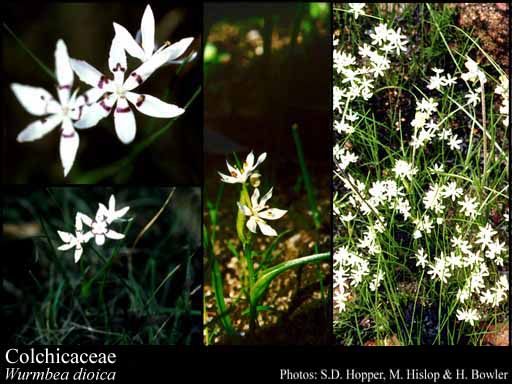- Reference
- Essai Propr.Méd.Pl. 56 (1804)
- Name Status
- Current







Scientific Description
Family Sometimes included in Liliaceae - Colchiceae.
Habit and leaf form. Herbs, or herbaceous climbers. Perennial; plants with a basal concentration of leaves, or with neither basal nor terminal concentrations of leaves; cormous, or rhizomatous (Gloriosa). Self supporting, or climbing; climbers stem twiners and tendril climbers. Mesophytic. Leaves alternate; spiral (usually), or distichous; petiolate (rarely), or sessile; sheathing; simple. Leaf blades entire; linear, or lanceolate; parallel-veined; without cross-venules. Leaf blade margins entire. Stem anatomy. Secondary thickening absent.
Reproductive type, pollination. Fertile flowers hermaphrodite. Unisexual flowers absent. Plants hermaphrodite, or dioecious, or gynodioecious. Floral nectaries present. Nectar secretion from the perianth (usually), or from the androecium (e.g. Colchicum).
Inflorescence and flower features. Flowers solitary, or aggregated in ‘inflorescences’; in cymes, in racemes, and in umbels. The terminal inflorescence unit cymose, or racemose. Inflorescences scapiflorous, or not scapiflorous; terminal, or axillary, or leaf-opposed. Flowers small to large; regular; 3 merous; cyclic; pentacyclic. Perigone tube present, or absent. Perianth of ‘tepals’; 6(–8); 1 -whorled (commonly in Australian genera, e.g. Wurmbea), or 2 -whorled (usually 3+3?); isomerous; petaloid; without spots, or spotted; similar in the two whorls (in size and form); white, or purple, or red, or yellow. Androecium 6. Androecial members free of the perianth (usually), or adnate (to the tepals); all equal; free of one another (usually), or coherent (e.g. Sandersonia, Wurmbea); rarely 1 - adelphous; 1 -whorled (e.g. Wurmbea), or 2 -whorled (usually, 3+3). Androecium exclusively of fertile stamens. Stamens 6; diplostemonous; alterniperianthial. Anthers dorsifixed, or basifixed; versatile, or non-versatile; dehiscing via longitudinal slits; extrorse (usually), or latrorse (very rarely almost introrse); tetrasporangiate. Gynoecium 3(–4) carpelled. The pistil 3(–4) celled. Carpels isomerous with the perianth. Gynoecium syncarpous; synovarious to synstylovarious (with free stylodia, or the single style tribrachiate); superior. Ovary plurilocular; 3(–4) locular. Styles 1, or 3; free to partially joined; apical. Stigmas 3; wet type, or dry type. Placentation axile. Ovules 10–22 per locule; anatropous to campylotropous.
Fruit and seed features. Fruit non-fleshy; dehiscent; a capsule. Capsules septicidal (usually), or loculicidal, or septicidal and loculicidal (e.g. Wurmbea). Fruit 30–60 seeded. Seeds 10–22 per locule. Seeds endospermic. Endosperm oily. Cotyledons 1 (conspicuously coleoptile-like). Embryo straight (rarely subglobose). Testa without phytomelan. Seedling. Hypocotyl internode absent. Seedling collar not conspicuous. Cotyledon hyperphyll compact; non-assimilatory. Coleoptile present. Primary root persistent, or ephemeral.
Geography, cytology, number of species. Holarctic, Paleotropical, and Cape. World distribution: Europe, Mediterranean, to Central Asia and North India, centred on the summer rainfall regions of southern Africa. X = 5–12(–19). About 200 species.